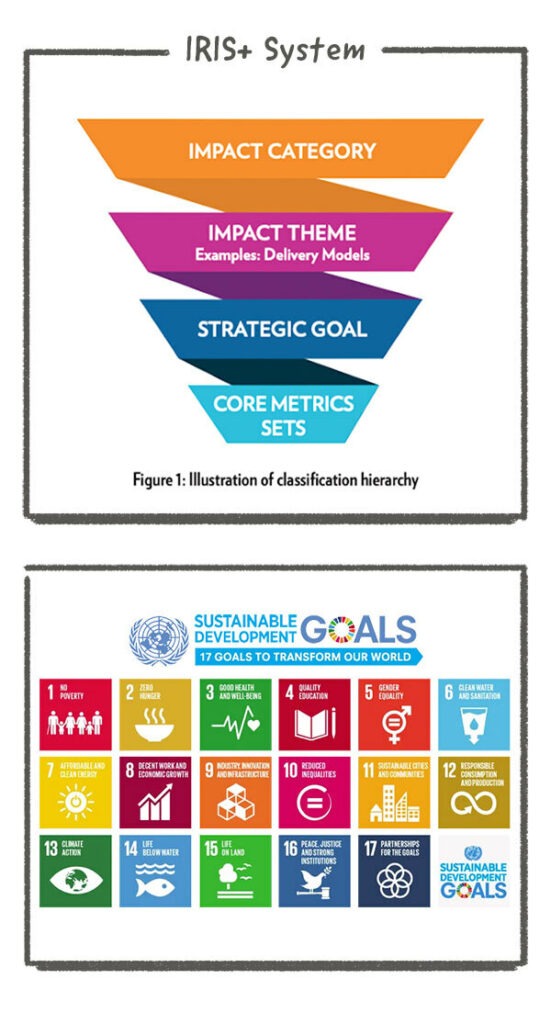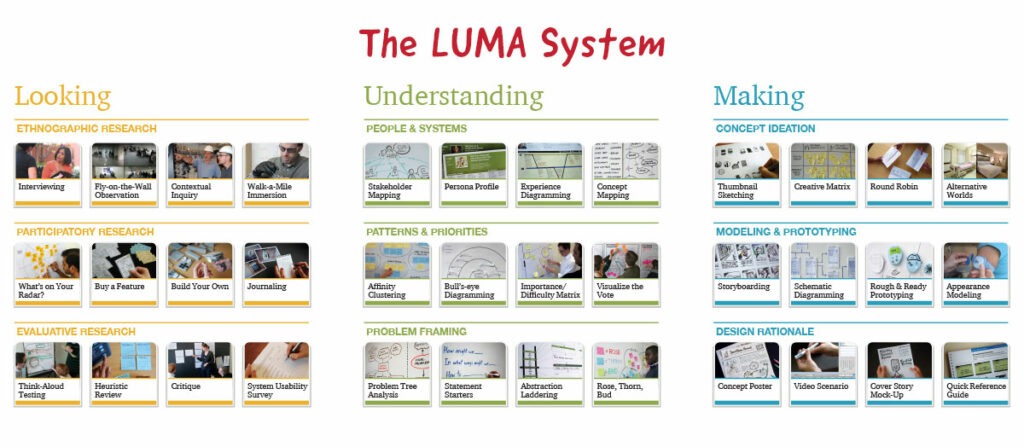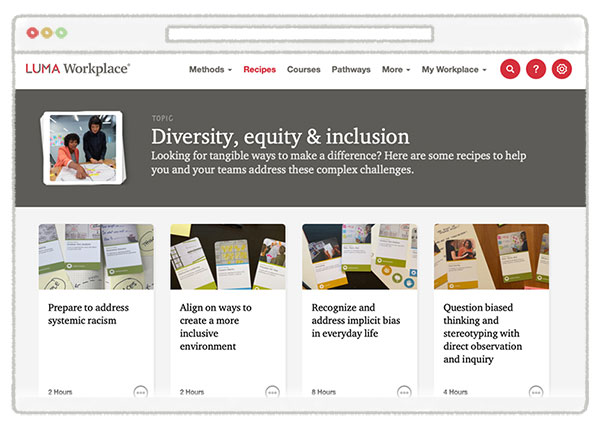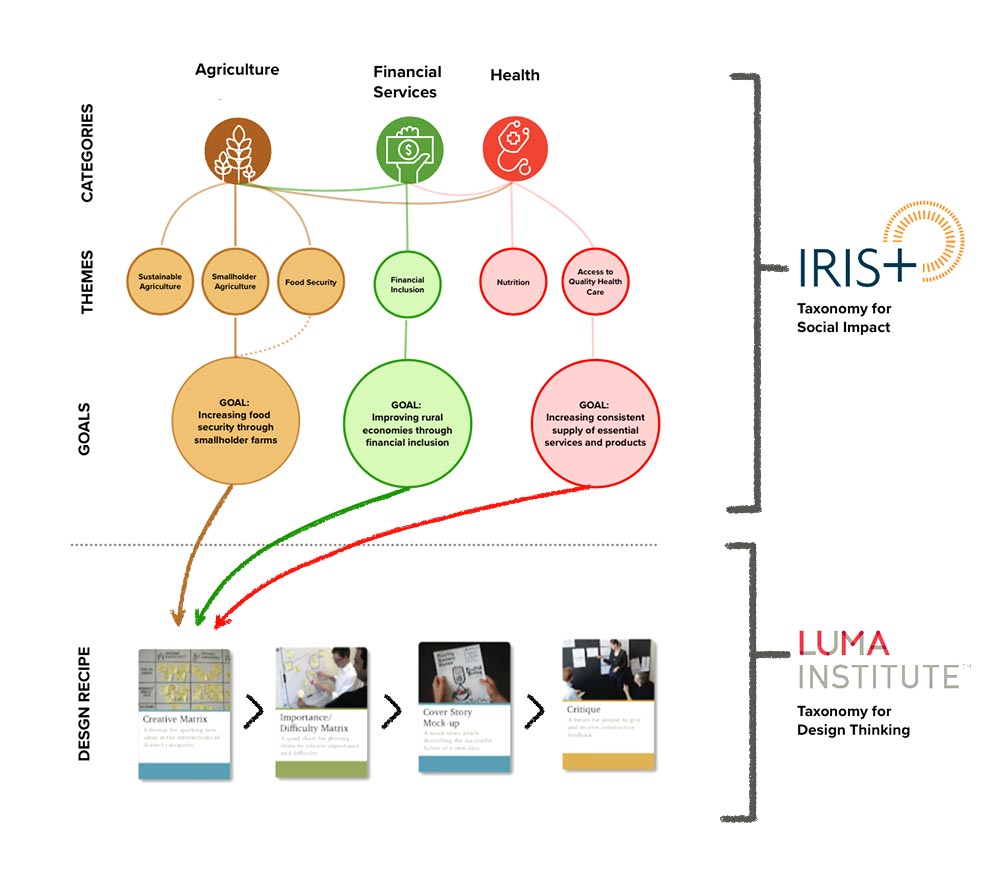An extreme fixation on financial profit yields a poverty of purpose. Meanwhile, a careful pursuit of profit and purpose returns riches beyond measure. This is the thinking behind the notion of managing a double bottom line that aims to produce financial returns and positive social impact.
By extension, we hear calls for attentiveness to a triple bottom line (profit, people, and planet), which begets advocacy for a fourth bottom line that includes additional impact in the realm of ethics, spirituality, and the like. All told, we are increasingly challenged to make things better — beyond the measures of financial gain.
The trouble is, there are many forces undermining the pursuit of profit and purpose. Among the culprits is an abundance of well-meaning efforts hindered by stakeholders talking past one another. Far too often, a lack of common terminology inhibits progress.
A potential antidote lies in the pairing of these two frameworks:
- The IRIS+ System provides a shared language to set goals for impact investing.
- The LUMA System provides a shared language for design thinking.

IRIS+ System: a taxonomy for impact investing
Impact investing seeks to use investment capital to yield both financial gains and positive social results. In May of 2021, the Global Impact Investing Network (GIIN) revised their recommendations for measuring, managing, and optimizing social and environmental impact. Their approach, known as the IRIS+ System, features a thematic framework based on years of rigorous research.
The system provides a common language for describing, assessing, communicating, and comparing impact performance. The framework includes a harmonized list of Strategic Goals organized by 28 themes within 17 categories.
When the IRIS+ taxonomy was originally established in 2019, it aligned with the UN’s 2030 Agenda for Sustainable Development (also known as the Sustainable Development Goals). Today, the IRIS+ System aligns with 50+ standards. It is suitable for use in conjunction with a robust range of frameworks and tools.
The IRIS+ System serves as a shared language for investors and design teams to constructively align on goals for social and environmental impact.
LUMA System: a taxonomy for design thinking
In July of 2021, LUMA Institute opened access to our systematic approach to creative problem solving. We help people learn and apply the principles and practices of human-centered design: the discipline of developing solutions in the service of others. Our framework, known as the LUMA System, has proven to be applicable within, and across, various sectors; ranging from commercial enterprises to government, nonprofits, and educational institutions.

The system features a collection of 36 methods organized by way of nine sections, spanning three essential skills: looking, understanding, and making. The LUMA System has been applauded by Harvard Business Review as a powerful “Taxonomy of Innovation.” It’s a curated collection of methods that can be combined to create plans for achieving your goals and objectives.
The LUMA System is not a prescribed process. It is a flexible, modular, and adaptive way of addressing wicked problems. The system can be used to create a custom process, or it can be integrated into existing processes, including, but limited to, Agile Development, Google Sprints, the UK Design Council’s Double Diamond, and so on.

Our digital resource, LUMA Workplace® includes 100+ examples of methods combined into “design recipes” and mapped to a variety of processes and relevant challenges. The most recent collection of LUMA recipes is focused on the clear and present matter of anti-racism and, more generally, the topic of designing for diversity, equity, and inclusion. Each recipe provides guidance and resources for critical and creative problem solving.
The LUMA System provides a shared language for collaborators applying the discipline of human-centered design in pursuit of social and environmental impact.
A pairing of frameworks for making things better
Let’s consider an example of how a team or organization might pursue positive social impacts through the combination of IRIS+ and LUMA. Collaborators could start to: (1) Identify Categories in the IRIS+ System that are related to their work at hand; (2) Identify a subset of relevant Themes; and (3) Select a set of Strategic Goals. Then, they could use LUMA Workplace® to navigate the LUMA System in order to find, or form, a design recipe to help address the clear and present challenge.

Profit + purpose = priceless
The combination of LUMA and IRIS+ is a great way to create and execute project plans. Further, the pairing of frameworks can serve to validate efforts to pursue a double, triple, or quadruple bottom line, because the IRIS+ System features:
- Core Metric Sets of evidenced-based practices for investment decision-making, and the
- IRIS Catalog of Metrics, a well-respected source of social and environmental performance metrics.
The 21st century is giving rise to a workforce that is increasingly conscientious about social and environmental impact. Consequently, companies that lack sincere purpose are likely to lose in the marketplace, but an earnest and rigorous pursuit of purpose and profit is priceless.
Related reading:
Deploying Design for Social Innovation at The Mission Continues
by Bill Lucas
Design Thinking for the Greater Good
Chapter 3: Igniting Creative Confidence at US Health and Human Services (FDA Case)
by Jeanne M. Liedtka and Randy Salzman

